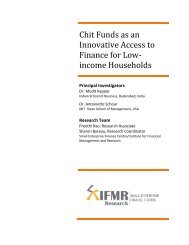Government of India Volume I: Analysis and Recommendations
Government of India Volume I: Analysis and Recommendations
Government of India Volume I: Analysis and Recommendations
Create successful ePaper yourself
Turn your PDF publications into a flip-book with our unique Google optimized e-Paper software.
CHAPTER 5<br />
Consumer protection<br />
5.1. Strategic picture<br />
A well functioning financial system should allow individuals, households <strong>and</strong> enterprises<br />
to efficiently allocate <strong>and</strong> manage their resources <strong>and</strong> protect themselves from risk, through<br />
the use <strong>of</strong> financial products <strong>and</strong> services. This involves complex interactions between<br />
consumers <strong>and</strong> financial service providers. At a first level, these interactions require<br />
the support <strong>of</strong> law to define <strong>and</strong> protect property rights <strong>and</strong> facilitate the enforcement<br />
<strong>of</strong> contracts.<br />
However, the complexity <strong>of</strong> financial markets <strong>and</strong> the existence <strong>of</strong> market failures in<br />
the form <strong>of</strong> information asymmetries, market externalities <strong>and</strong> differences in the bargaining<br />
powers <strong>of</strong> consumers <strong>and</strong> service providers, create the need for a higher st<strong>and</strong>ard <strong>of</strong><br />
protection for financial consumers. The need for financial consumers to be treated fairly<br />
makes it appropriate to adopt a more intrusive approach to financial regulation, when<br />
compared with most other fields.<br />
Currently, the strategy in <strong>India</strong>n finance is focused on the doctrine <strong>of</strong> caveat emptor:<br />
let the buyer beware. Beyond protection from fraud <strong>and</strong> provisions to ensure full disclosure,<br />
consumers are generally left to their own devices. After extensive analysis <strong>and</strong><br />
debate on these questions, the Commission believes that to the extent that consumers<br />
<strong>of</strong> financial services are more vulnerable than consumers <strong>of</strong> ordinary goods <strong>and</strong> services,<br />
higher st<strong>and</strong>ards <strong>of</strong> protection ensured by special efforts <strong>of</strong> the State are justified.<br />
The vulnerability <strong>of</strong> consumers reflects a major gap in <strong>India</strong>n financial regulation,<br />
which needs to be addressed. As such, the Commission recommends the adoption <strong>of</strong> a<br />
consolidated, non-sector-specific, consumer protection framework for the entire financial<br />
system that will empower <strong>and</strong> require regulators to pursue consumer protection for<br />
the financial activities regulated by them. In this context, the draft Code approaches the<br />
problems <strong>of</strong> consumer protection on two fronts: prevention <strong>and</strong> cure.<br />
Prevention requires regulation-making <strong>and</strong> enforcement across the entire financial<br />
system from the viewpoint <strong>of</strong> consumer interests. For example, looking at questions <strong>of</strong><br />
remuneration <strong>and</strong> conflicts <strong>of</strong> interest, when a sales agent sells a financial product to a<br />
household, <strong>and</strong> gets paid a fee by the producer <strong>of</strong> this financial product, is there a problem<br />
with conflicts <strong>of</strong> interest? How do we evolve a structure where the provider acts in the<br />
best interest <strong>of</strong> the consumer? Regulators should be obliged to grapple with questions<br />
such as these.<br />
FINANCIAL SECTOR LEGISLATIVE REFORMS COMMISSION 43



